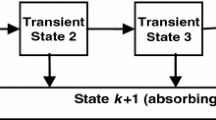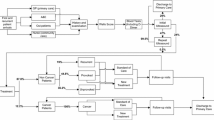Abstract
A discrete event simulation models the progress of patients who have had a coronary event, through their treatment pathways and subsequent coronary events. The main risk factors in the model are age, sex, history of previous events and the extent of the coronary vessel disease. The model parameters are based on data collected from epidemiological studies of incidence and prognosis, efficacy studies, national surveys and treatment audits. The simulation results were validated against different sources of data. The initial results show that increasing revascularisation has considerable implications for resource use but has little impact on patient mortality.
Similar content being viewed by others
References
H. Babad, C. Sanderson, B. Naidoo, I. White and D. Wang, The development of a simulation model of primary prevention strategies for Coronary Heart Disease, Health Care Management Science 5 (2002) 269-274.
D.C. Bensley, P.S. Watson and G.W. Morrison, Pathways of coronary care — a computer-simulation model of the potential for health gain, IMA Journal of Mathematics Applied in Medicine and Biology 12 (1995) 315-328.
L. Bonneax, J.J. Barendregt, K. Meeter, G.J. Bonsel and P.J. van der Maas, Estimating clinical morbidity due to ischemic heart disease and congestive heart failure: The future rise of heart failure, American Journal of Public Health 84 (1994) 20-28.
The Bypass Angioplasty Re-vascularisation Investigation (BARI) Investigators, Comparison of coronary bypass surgery with angioplasty in patients with multivessel disease, The New England Journal of Medicine 335 (1996) 217-223.
K.W. Clarke, D. Gray and J.R. Hampton, Implication of prescriptions for nitrates: 7 year follow up of patients treated for angina in general practice, British Heart Journal 71 (1994) 38-40.
R. Davies, Simulation for planning services for patients with coronary artery disease, European Journal of Operational Research 71 (1994) 323-332.
H.T.O. Davies and R. Davies, Simulating health systems: Modelling problems and software solutions, European Journal of Operational Research 87 (1995) 35-44.
M.A. de Belder, H.H. Gray, L.D.R. Smith and A.F.R. Rickards, Cardiac Intervention Procedures in the United Kingdom in 1997 (British Cardiovascular Intervention Society, 1998).
D.P. de Bono and A. Hopkins, The investigation and management of stable angina, Journal of the Royal College of Physicians of London 27 (1993) 267-273.
Department of Health, Health Survey for England 1994, Findings, Vol. I (HMSO, 1996).
Department of Health, Health Survey for England 1998, Findings, Vol. I, Survey Methodology and Documentation, Vol. II (The Stationary Office, 2000).
Department of Health, National Service Framework: Coronary Heart Disease, Modern Standards and Service Models (The Stationary Office, London, 2000).
Department of Health, Saving Lives: Our Healthier Nation (The Stationary Office, London, 1999).
D. Gill, R. Mayou, M. Dawes and D. Mant, Presentation management and course of angina and suspected angina in primary care, Journal of Psychosomatic Research 46 (1999) 349-358.
R.J. Goldberg, T. Young, D. Gray, A.M. Skene and J.R. Hampton, Inpatient deaths from acute myocardial infarction 1982â€"1992: Analysis of data in the Nottingham heart attack register, British Medical Journal 315 (1997) 159-164.
R.A. Henderson, C.L. Raskino and J.R. Hampton, Variations in the use of coronary arteriography in the UK: The Rita trial coronary arteriogram register, Quarterly Journal of Medicine 88 (1995) 167-173.
Hospital Episode Statistics, Department of Health, London (1998) (personal communication).
H.N. Hultgren and P. Peduzzi, Relation of severity of symptoms to prognosis in stable angina pectoris, American Journal of Cardiology 54 (1984) 988-993.
D.G. Julian, M.E. Bertrand, A. Hjalmarson, K. Fox, M.L. Simoons, L. Ceremuzynski, A. Maseri et al., Management of stable angina pectoris. Recommendations of the Task Force of the European Society of Cardiology, European Heart Journal 18 (1997) 394-413.
B.E. Keogh and R. Kinsman, National Audit Cardiac Surgical Database Report (The Society of Cardiothoracic Surgeons of Great Britain and Ireland, London, 1998).
D.J. Lerner and W.B. Kannel, Patterns of coronary heart disease morbidity and mortality in the sexes: A 26-year follow-up of the Framingham population, American Heart Journal 111 (1986) 383-390.
R. Lim, I. Kreidieh, L. Dyke, J. Thomas and D.S. Dymond, Exercise testing without interruption of medication for refining the selection of mildly symptomatic patients for prognostic coronary angiography, British Heart Journal 71 (1994) 334-340.
D.M. Lloyd-Jones, D.O. Martin, M.G. Larson and D. Levy, Accuracy of death certificates for coding coronary heart as the cause of death, Annals of Internal Medicine 129 (1998) 1020-1026.
S. Mui, Projecting coronary heart disease incidence and cost in Australia: Results from the incidence module of the cardiovascular disease policy model, Australian and New Zealand Journal of Public Health 23 (1999) 11-19.
Natural history of coronary artery disease, Bulletin of New York Academic Medicine 48 (1972) 1109-1125.
R.M. Norris, Sudden Cardiac Death and Acute Myocardial Infarction in Three British Health Districts: The UK heart attack study (British Heart Foundation, London, 1998).
Office for National Statistics, Annual Abstract of Statistics, 1998 (The Stationary Office, London, 1999).
S.J. Pocock, R.A. Henderson, A.F. Rickards, J.R. Hampton, S.B. King, C.W. Hamm et al., Meta-analysis of randomised trials comparing coronary angioplasty and bypass surgery, Lancet 346 (1995) 1184-1189.
F. Ragmin, L. Wallentin, E. Swahn, F. Kontny, S. Husted, B. Lagerqvist and E. Stahle, Long-term low molecular mass heparin in unstable coronary artery disease: FRISC II prospective randomised multicentre study, Lancet 354 (1999) 701-707.
Royal Brompton hospital, PRAIS UK dataset (1999) (personal communication).
Royal College of General Practitioners, Morbidity statistics from general practice, 1991–1992 (OPCS, London, 1994).
Scottish Intercollegiate Guidelines Network, Coronary Revascularisation in the Management of Stable Angina Pectoris (Royal College of Physicians, Edinburgh, 1998).
S.J. Sutcliffe, A.K. Sutcliffe and D.A. Wood, The clinical incidence of fatal and non-fatal coronary heart disease in the population, Heart 8 (Supplement 1) (1999) (Abstract) (personal communication).
J. Tsevat, M.C. Weinstein, L.W. Williams, A.N.A. Tosteson and P.A. Goldman, Expected gains in life expectancy from various coronary heart disease risk factor modifications, Circulation 83 (1991) 1194-1201.
M.C. Weinstein, P.G. Coxson, L.W. Williams, T.M. Pass, W.B. Stason and L. Goldman, Forecasting coronary heart disease incidence mortality and cost: The Coronary Heart Disease Policy Model, American Journal of Public Health 77 (1987) 1417-1426.
M.C. Wolfson, POHEM â€" a framework for understanding and modelling the health of human populations, WHO Statistics Quarterly 47 (1994) 157-175.
S. Yusuf, D. Zucker, P. Peduzzi, L.D. Fisher, T. Takaro, J.W. Kennedy et al., Effect of coronary artery bypass graft surgery on survival: Overview of 10-year results from randomised trials by the Coronary Artery Bypass Graft Surgery Trialists Collaboration, Lancet 344 (1999) 563-570.
Author information
Authors and Affiliations
Rights and permissions
About this article
Cite this article
Cooper, K., Davies, R., Roderick, P. et al. The Development of a Simulation Model of the Treatment of Coronary Heart Disease. Health Care Management Science 5, 259–267 (2002). https://doi.org/10.1023/A:1020378022303
Issue Date:
DOI: https://doi.org/10.1023/A:1020378022303




